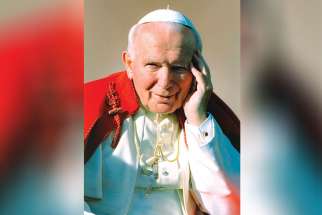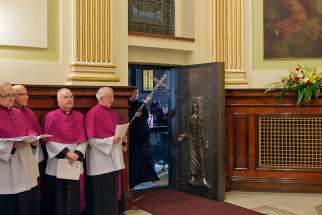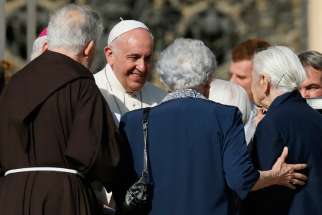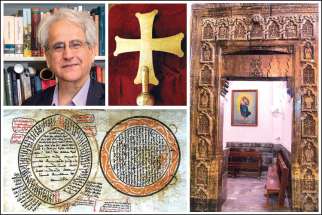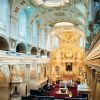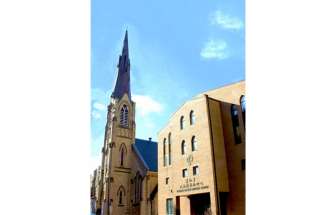Evangelium Vitae at 20: ushering in a culture of life
Twenty years ago, on the Feast of the Annunciation 1995, St. John Paul II published one of his signature encyclicals, Evangelium Vitae (The Gospel of Life). It’s important to return to the richness of that teaching, as many who oppose the Church’s pro-life witness having been making mischief with Pope Francis’ remark that Catholics should not be obsessed with abortion.
350,000 pass through Quebec Holy Door
A year of celebration in the Archdiocese of Quebec drew more than 350,000 pilgrims through the Holy Door of Quebec City’s Cathedral-Basilica of Notre Dame de Québec.
Pope: Greed, throwaway culture fuel 'hidden euthanasia' of elderly
VATICAN CITY - Pope Francis warned against the abandonment and neglect of the elderly, calling it a "hidden euthanasia" rooted in today's "poisonous" culture of disposal and an economic system of greed.
Scholar decries ‘plague’ wiping out history
As Amir Harrak watched the news this summer, the Toronto scholar saw a history, culture and language that he devoted his life to understanding being turned to dust. Churches, monasteries, mosques blown up, libraries full of ancient manuscripts burned and the people who still speak and live according to the language of Jesus and his Apostles dispersed. The news out of Iraq could not have been worse.
Families encouraged to promote life, peace and love
OTTAWA - The Catholic Organization for Life and Family (COLF) is urging families to live up to a vocation of promoting life, peace and a culture of love.
Sault’s new school aims to preserve French culture
For the French Catholic community in Sault Ste. Marie, Ont., the newly constructed École Notre-Dame-du-Sault will provide students with the sense of belonging necessary for preserving their French identity.
“The community really wanted us to unite all of our students at one site and offer students a high quality school where they get to start off in Kindergarden and finish off in Grade 12,” said Paul de la Riva, spokesperson for the Conseil scolaire catholique du Nouvel-Ontario (CSCNO). “The board’s main goal is to keep our students from Kindergarden to Grade 12.”
But that isn’t what had been happening in northern Ontario’s third largest city. While there are two elementary schools — École Cardinal-Léger and École Notre-Dame-des-Écoles which was expanded to become the new school — it had been renting space at a local Catholic secondary school to house its own high school.
De la Riva said this lack of independent identity caused many students to move to the English boards, either public or Catholic, when they entered Grade 9.
“All our schools weren’t really up to par, they were old schools and they really weren’t meeting the needs of the community,” he said. “When you’re renting a spot or area in another school you may have your own wing but you’re always looking at what the others are doing, the bigger section of the school. By having our students in their own building it will build a sense of belonging.”
That’s what prompted the five-year, $12.5- million project of renovating, expanding and rebranding École Notre-Dame-des-Écoles for which the province put forward $11.26 million, with the additional funds coming from the board’s budget.
It isn’t just CSCNO students who will benefit from this new building, which held its official opening ceremony on Oct. 26. Along with housing the more than 300 students from Junior Kindergarden to Grade 12, the building will also host the French-language adult learning centre and the Centre francophone de Sault-Ste-Marie, as well as play a supportive role for many off site organizations.
It is hoped this will help establish the new school as a hub for francophone pride.
“The school’s community component is something we hold dear and which will certainly contribute to its growth and to the vitality of the francophone community in Sault Ste. Marie and the Algoma District,” said Lyse-Anne Papineau, CSCNO director of education, in a news release. “We strongly believe that the new school will become a key City of Sault Ste. Marie partner for many years to come.”
Not only does the board hope that more students will remain pupils of its system, the board also hopes to attract new students to the francophone system with the modern school which has a capacity of 565 students. To help ensure success in maxing out this expanded capacity, the school houses a French-language day care program for up to 30 children.
“It’s really important to support the parents in preserving their language,” said de la Riva. “If children are not going to French schools, we know that one generation from now you’re losing many francophones who may have knowledge of the language but will not have the skills or capacity to really speak the language, transmit the language and culture to their kids.”
The ‘art’ of Catholic faith
My younger brother isn’t what I would call “cultured.” An 18-year-old on a boat cruise around Europe has priorities other than discovering the famous basilicas or the incredible detail in their paintings and sculptures. Before our trip last month, my mom and I talked a lot about whether or not Aidan would care to see — much less appreciate — all of the sights. How much groaning could we put up with while we bounced between pieces of history in these old Europeans cities? A fair bit, it turns out.
But something changed when we visited the Vatican. The complaining gave way to a flurry of questions our tour guide tried to answer before my brother interrupted with another question. He forgot how tired and hungry he was, how much his feet hurt or how comfy his bed was back on the cruise ship. He was totally immersed in the magnificence of the city. It seemed obvious to him that St. Peter’s Basilica wasn’t just another old church.
But that’s exactly what it is: an old church. St. Peter’s just happens to be a very important old church. After all, the entire state of the Vatican was built around it.
The Vatican’s importance as the epicentre of our Catholic faith is lost on most 18-year-olds. They may know some details, but it’s much tougher to grasp the weight they carry. I thought the Vatican was just another old church too.
When I looked at pictures of St. Peter’s Basilica, I could see it was big, but I couldn’t see it was magnificent until I was standing in it. Similarly, a Google image search of the Sistine Chapel won’t make you feel the way you do when you’re looking with your neck craned back at the scenes painted on the ceiling. You don’t see the care, detail or incredible talent it took to create it. You don’t feel the intangible, indescribable something that makes the Vatican more than a big church until you walk through its museums and feel it for yourself.
It’s the art that creates this wonder. “It makes you think about human potential,” our tour guide mused while looking at the detail along every foot of the ceiling in St. Peter’s. People — young people in particular — are drawn in by it.
Amidst all the facts about the scaffolds they used or Michelangelo’s age when he carved the Pieta, there is a narrative. The art tells the story of our faith, capturing its divine messages and old parables. The art creates the questions which lead to discussion. Questions like why was the man who pierced the side of Christ canonized?
From there, the messages of our faith spread between curious onlookers, even after they leave the city. The difference between the art of the Vatican and many other efforts to spread the same messages is one of esthetics. The art gives onlookers only two options: stand in silent admiration or ask questions about it.
But the answer is just a bonus. Spiritual enrichment comes from all the people there who are doing the same thing. There is a sense of solidarity that transcends age, race, sex and even religion. Anyone can appreciate the art, regardless of whether they subscribe to the beliefs embedded in its narrative. That is what makes the city holy. That’s why St. Peter’s is more than just another old church.
Culture has turned into Quebec’s new religion
QUEBEC CITY - It used to be that Quebecers who wanted to hear good preaching or be instructed on right and wrong went to Mass on Sunday and listened to their priest. The clergy were the principle arbiters of public and private morality in all spheres of life in Quebec. They preached on everything from how to dress, who to consort with (or not) and what to read, think vote and so on.
One famous saying from this era — “heaven is blue and hell is red” — was a not-so-veiled reference to vote Conservative in elections. The Church believed the “red” Liberals stood for secular reform and social change that would lead people away from their faith. And that’s what happened, people eventually voted red in order to hasten improvements in material living standards and, as predicted, what eventually followed was a widespread abandonment of faith in Quebec.


